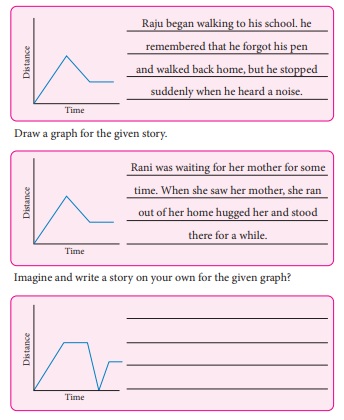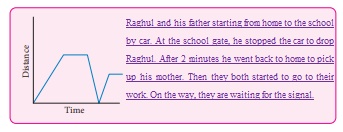Science : Term 1 Unit 2 : Force and Motion
Evaluation
I. Choose the best answer.
1. A particle is moving in a circular path of radius r. The displacement after half a circle would be
a. Zerob.
b. R
c. 2 r.
d. r / 2
Answer : c. 2r
2. Which of the following figures represent uniform motion of a moving object correctly?
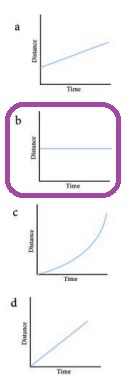
3. Suppose a boy is enjoying a ride on a marry go round which is moving with a constant speed of 10 m/s. It implies that the boy is
a. at rest
b. moving with no acceleration
c. in accelerated motion
d. moving with uniform velocity
Answer : c. in an accelerated motion
4. From the given v-t graph it can be inferred that the object is
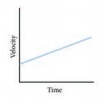
a. in uniform motion
b. at rest
c. in non uniform motion
d. moving with uniform acceleration
Answer : d. moving with uniform acceleration
5. How can we increase the stability of an object?
a. lowering the centre of gravity
b. raise the centre of gravity
c. increasing the height of the object
d. shortening the base of the object
Answer : a. lowering the centre of gravity
II. Fill in the blanks.
1. The shortest distance between the two places is displacement.
2. The rate of change of velocity is acceleration.
3. If the velocity of an object increases withrespect to time, then the object is said to be in positive acceleration.
4. The slope of the speed–time graph gives acceleration of a body.
5. In neutral equilibrium its centre of gravity remains at the same height when it is displaced.
III. Match the following:
Displacement – Knot
Light travels through vacuum – Geometric centre
Speed of ship – Metre
Centre of gravity of the geometrical shaped object – Larger base area
Stability – Uniform velocity
Answer:
1. Displacement – Metre
2. Light travels through vacuum – Uniform velocity
3. Speed of ship – Knot
4. Centre of gravity of the geometrical shaped object- Geometric centre
5. Stability – Larger base area
IV. Analogy
1. velocity : metre/ second : : acceleration : meter / second2.
2. length of scale : metre : : speed of aeroplane: knot.
3. displacement / time : velocity : : speed / time: acceleration.
V. Give very short answer.
1. All objects having uniform speed need not have uniform velocity. Describe with the help of examples.
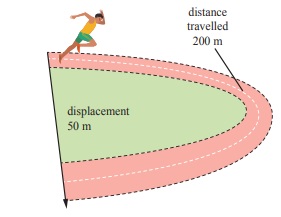
If an athlete in the diagram takes 25 s to complete a 200 m sprint event. Then
Speed = distance / time
= 200 / 25
= 8 m / s
He travels with an uniform speed since he covers equal distances in equal intervals of time.
velocity = displacement / time
= 50 / 25
= 2 m/s
∴ Velocity is not uniform because there is change in direction.
2. “She moves at a constant speed in a constant direction”. Rephrase the same sentence in fewer words using concepts related to motion.
Saphira moves with a uniform velocity.
3. Correct your friend who says “The acceleration gives the idea of how fast the position changes”.
The acceleration gives the idea of change of velocity with time.
V. Give short answer.
1. Show the shape of the distance – time graph for the motion in the following cases.
a. A bus moving with a constant speed.
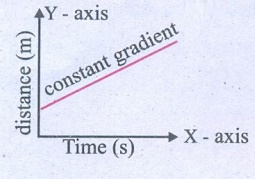
b. A car parked on a road side.

2. Distinguish between speed and velocity.
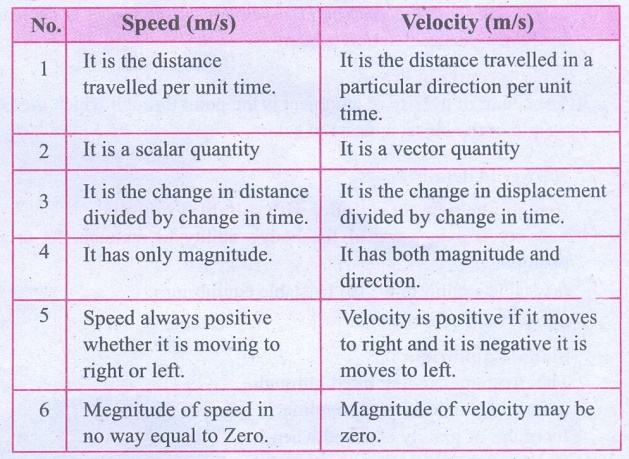
Speed (m/s)
1. It is the distance travelled per unit time.
2. It is a scalar quantity
3. It is the change in distance divided by change in time.
4. It has only magnitude.
5. Speed always positive whether it is moving to right or left.
6. Megnitude of speed in no way equal to Zero.
Velocity (m/s)
1. It is the distance travelled in a particular direction per unit time.
2. It is a vector quantity
3. It is the change in displacement divided by change in time.
4. It has both magnitude and direction.
5. Velocity is positive if it moves to right and it is negative it is moves to left.
6. Magnitude of velocity may be zero.
3. What do you mean by constant acceleration?
An object undergoes uniform (constant) acceleration when the change (increase or decrease) in its velocity for every unit of time is the same. Table shows a moving bus with uniform acceleration.
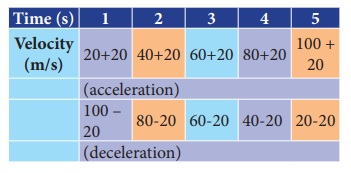
When the velocity of the object is increasing by 20 m/s the acceleration is 20 m/s2. When the velocity of the object is decreasing by 20 m/s the deceleration is 20 m/s2.
When the velocity of the object is decreasing by 20m/s the deceleration is 20 m/s2.
Deceleration = Decrease in velocity / Deceleration = t = 20/20 = 1s
The velocity of the object is decreasing by 20m/s in one second.
4. What is centre of gravity ?
The centre of gravity of an object is the point through which the entire weight of the object appears to act.
VII. Answer in detail.
1. Explain the types of stability with suitable examples.
Stability is a measure of the body’s ability to maintain its original position.
(a) Stable equilibrium
(b) Unstable equilibrium
(c) Neutral equlibrium
Stable Equlibrium :
The frustum can be tilted through quite a big angle without toppling. Its centre of gravity is raised when it is displaced.
The vertical line thorugh its centre of gravity still falls within its base. So it can return to its original position.
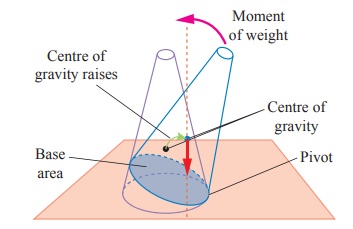
Unstable Equilibrium :
The frustum will topple with the slightest tilting. Its centre of gravity is lowered when it is displaced.
The vertical line through its centre of gravity falls outside its base.

Neutral Equilibrium :
(d) It does not cause to topple.
(e) The frustum will rolls about but does not topple.
(f) Its centre of gravity ramains at the same height when it it displaced.
(g) The body will stay in any position to which it has been displaced.
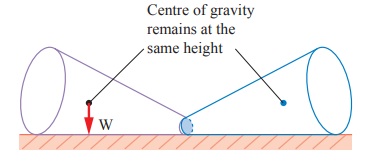
2. Write about the experiment to find the centre of gravity of the irregularly shaped plate.
Determination of centre of gravity of irregular shaped objects.
Apparatus : Irregularly shaped plate string, pendulum bob, stand.
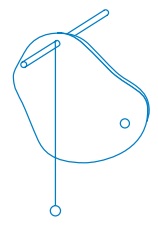
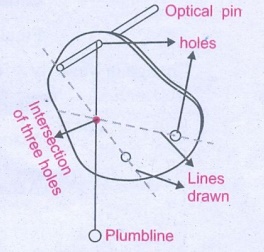
1. Make three holes in the lamina.
2. Suspend the lamina from the optical pin through one of the holes as shown.
3. Suspend the plumbline from the pin and mark and position of the plumbline on the lamina.
4. Draw lines on the lamina representing the positions of the plumbline.
5. Repeat the above steps for the holes.
6. Label the intersection of the three lines as X, the position of the centre of gravity of the lamina.
VIII. Numerical problems.
1. Geetha takes 15 minutes from her house to reach her school on a bicycle. If the bicycle has a speed of 2 m/s, calculate the distance between her house and the school.
Time taken by Geetha = 15 minutes
= 15 × 60 seconds
= 900 s
Her speed = 2 m/s
Distanced moved by her in 1 s = 2 m
∴ in 900 s = (900 s / 1 s) × 2 m
= 1800 m = 1.8 km
2. A car started from rest and travelling with velocity of 20 m /s in 10 s. What is its acceleration?
Initial velocity (U) = 0 m /s
Final Velocity (V) = 20 m /s
Change in Velocity = (V – U) = (20 – 0 ) = 20 m/s
Time taken for this change in velocity = 10 s
Acceleration = change in velocity / time
a = 20 m/s / 10 s = 2 m/s2
3.A bus can accelerate with an acceleration 1 m / s2. Find the minimum time for the bus to reach the speed of 100 km / s from 50 km / s.
Acceleration of the bus a = 1 m/s2
Change in speed = (V – U) = (100 – 50) km / hr
= 50 × 1000 m/hr
= (50000 / 60) m/ minute
= (50,000 / 60×60 ) m/second
Time taken for this change of speed = change in speed / acceleration
= [ 50,000 m/s ] / [ 60 × 60 × 1 ms2] = 125 /9 s
= 13.89 seconds
IX. Fill in the boxes.

Student Activities, Numerical Problems
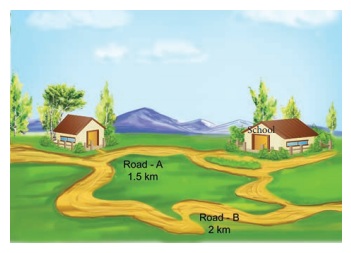
As shown in the above picture, Kavitha can reach her school in two ways. Can you tell, by choosing which path she could reach the school early.
Road A
Road B
Road A (1.5 km)
Road B (2 km)
∴ Road A is the answer
======== =========
Look at the nearby picture
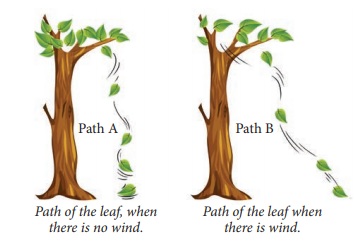
In which path the leaf will reach the ground first? Path A
======== ======== ====== ======
Uma and Priya are friends studying in the same school. After school hours, they go to the nearby playground, play games and return back home. Oneday Uma told that she would reach the playground after visiting her grandmother’s house . The path in which they took reached the playground is shown here.
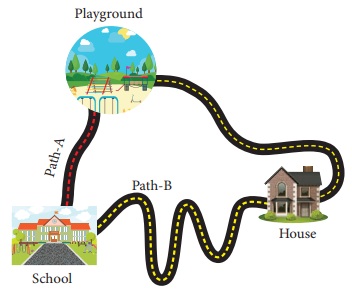
Take a twine and measure the length of the two paths (A & B). Which is the longest path among the two? Path B
From the above examples, we could conclude that when an object travel from one place to another, it will reach faster if it travels along the straight line path. The straight line path is the shortest distance between two points.
======== ======== ====== ======

Figure shows the motion of a person between two places A and B.
He travels 10 km in first path. In the second path, he travels 7 km.
The distance between A and B via first path is 10 km. In the second path the distance is 7 km. The shortest distance between the two places is 5 km represented as 2. So the displacement is 5 km. (In east direction)
======== ======== ====== ======
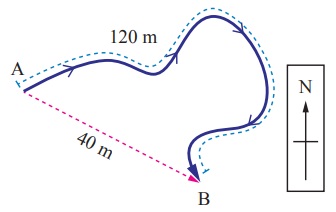
The path of an object travelling from A to B is shown in figure. Total distance travelled by the object is 120 m. The displacement of the object is 40 m (south-east direction)
======== ======== ====== ======
The path in which a rabbit ran is shown in figure. Find the distance and displacement of it in the two figures. Let us consider that each square is in an unit of one square meter. The rabbit starts from point A and reaches the point B.
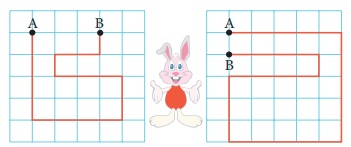
i) Distance – 17 m Displacement – 3m
ii) Distance – 27 m Displacement – 1m
When will the distance and displacement be equal. Explain. But the starting and finishing points should be different.
When travelling along the straight line path the distance and displacement be equal.
When we represent the displacement, we use a positive or negative sign depending on the direction with which it travels.

======== ======== ====== ======
Here we can consider the starting point as A and while the object moves from A to B the displacement is considered to be positive and from B to A it is negative.
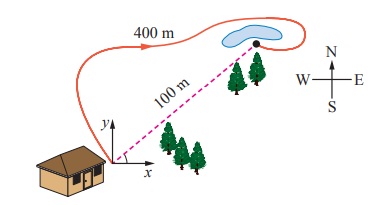
Answer the following questions:
* Subha goes to the nearby playground from her home.
1. What is the distance she travelled?
400 m
2. What is her displacement?
The object moves in a straight line in one direction without turning back.
* The distance travelled by an object is 15 km and its displacement is 15 km. What do you infer from this?
The distance of a person = 30 km Displacement = 0 km.
* The distance of a person is 30 km and his displacement is 0 km. What do you inferfrom this?
(i.e.) The initial and the final position is same.
Nautical mile
Nautical mile is the unit for measuring the distance in the field of aviation and sea transportation. One nautical mile is 1.852 km.
The unit for measuring the speed of aeroplanes and ships is knot. One knot is the speed taken to travel one nautical mile in hour.
======== ======== ====== ======

If an athlete in the diagram takes 25 s to complete a 200 m sprint event. Find her speed and velocity.
Speed = distance / time
=200 / 25
=8 m/s
velocity = displacement /time
=50/25
=2 m/s
======== ======== ====== ======
E.g. Figure shows a car that travels 5 km due east and makes a U – turn to travel another 7 km. If the time taken for the whole journey is 0.2 h. Calculate the average velocity of the car.
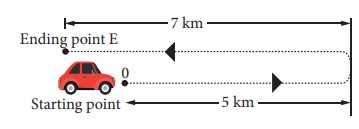
Average velocity = total displacement/time taken. (taking the direction due east of point O as positive)
= (5–7)/0.2
= –2 / 0.2
= –10 km/h (or) –10 × 5/18 = 25/9
= –0.28 m / s
======== ======== ====== ======
Answer the following questions:
* Calculate the velocity of a car travelling with a uniform velocity covering 100 m distance in 4 seconds.
Velocity = Sistance / time = 100/4 = 25 m/s
* Usain Bolt covers 100 m distance in 9.58 seconds. Calculate his speed. Who will be the winner if Usain Bolt comepetes with a Cheetah running at a speed of 30 m/s?
Speed of Usain Bolt = 10.43 m/s
Speed of cheetah = 30 m/s
Cheetah will be the winner.
* You are walking along east covering a distance of 4 m, then 2 m towards south,then 4 m towards west and at last 2 m towards north. You cover the total distancein 21 seconds, what is your average speed and average velocity?
Total distance covered = 12 m
Total time taken =21 seconds
Average speed = Total distance covered / total time = 12m / 21 = 0.571 m/s
Average velocity = 0 m/s
12m / 21 = 0.571 m/s
Average velocity = 0 m/s
Average velocity is zero because the starting point and the finishing point is same
∴Displacement is zero so, average velocity is also
Average velocity = Total distance / time
======== ======== ====== ======
In other words, the object undergoes acceleration when its speed and/or direction change(s).


The velocity at different times of a train departing direction is given in the figure. Analyse this and complete the table .

Answer:

Analysis:
When the train covers the distance A to B and B to C, it is accelerated motion.
When it covers the distance C-D, there is no acceleration (i.e) uniform velocity.
When it covers the distance D to E and E to F it has negative acceleration or deceleration or retardation, (i.e.) Its velocity decreases with respect to time.
======== ======== ====== ======
Tell me

A car at rest starts to travel in a straight path. It reaches a velocity of 12 m/s in 4 s . What is its acceleration. Assuming that it accelerates uniformly?
Initial velocity u =0 m/s (since the car starts from rest)
Final velocity (v) =12 m /s
Time taken (t ) =4 s
acceleration ( a ) =(v – u) / t
= (12–0)/4
=3 m / s2
==== ======== =============
See how brisk I am !

My name is cheetah. I can run at a great speed. Do you know what my speed is? 25 m/s to 30 m/s. My speed changes from 0 to 20 m/s in 2 second. See how good my acceleration is !
Tell me
From the above information, can you calculate the acceleration of the cheetah?
Acceleration of the cheetah = [ Final velocity(v) – Initial velocity(u) ] / [time taken]
= [ v – u ] / t = 20-0 / 2 = 20/2 = 10 m/s2
Acceleration of the cheetah = 10 m/s2
==== ======== =============
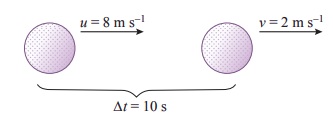
The velocity of a golf ball rolling in a straight line changes from 8 m/s to 2 m/s in 10 s. What is its deceleration, assuming that it is decelerating uniformly ?
Initial velocity (u) =8 m/s
Final velocity (v) =2 m/s
Time taken(t) =10 s
Acceleration (a) =(v – u)/t
=(2 – 8)/10
= –0.6 m/s2
The deceleration is –0.6 m/s2
==== ======== =============
Table shows a moving bus with uniform acceleration.

When the velocity of the object is increasing by 20 m/s the acceleration is 20 m/s2 When the velocity of the object is decreasing by 20 m/s the deceleration is 20 m/s2.
When the velocity of the object is decreasing by 20m/s the deceleration is 20 m/s2.
Deceleration = Decrease in velocity / Deceleration = t = 20/20 = 1s
The velocity of the object is decreasing by 20m/s in one second.
= ==== ======== =============

Figure shows a car travelling along a straight line away from the starting point O. The distance of the car is measured for every second. The distance and time are recorded and a graph is plotted using the data. The results for four possible journeys are shown below.
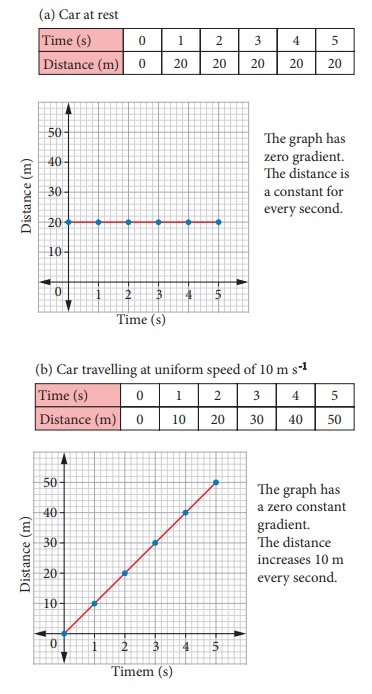
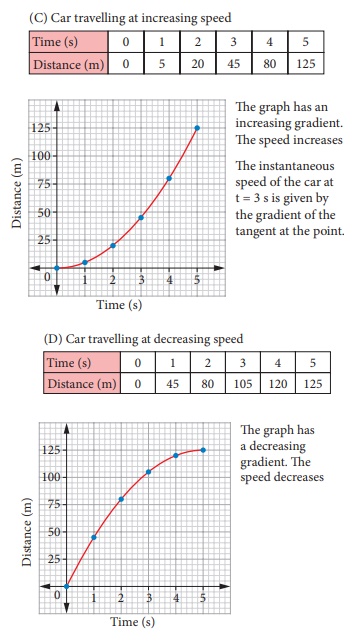
= ==== ======== =============
Let us consider a bus travelling from Thanjavur to Trichy. The speed of the bus is measured for every second. The speed and time are recordedand a graph is plotted using the data. The results for four possible journeys are shown.
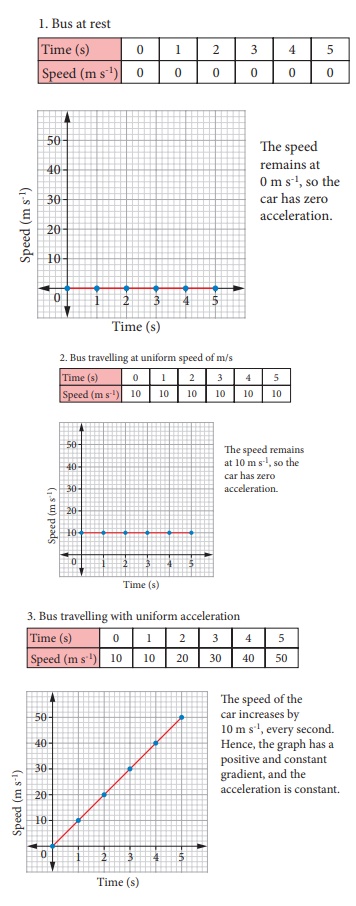
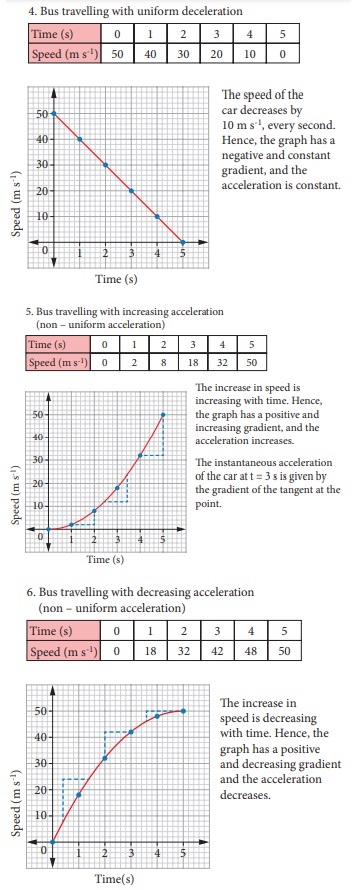
=========== ==============
